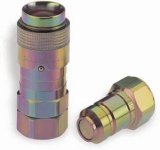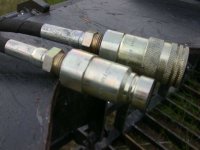Osconda
Silver Member
- Joined
- Apr 14, 2005
- Messages
- 182
- Tractor
- New Holland TC55DA, delivered 05/25/2005
When I bought my tractor I also got a root grapple for my loader. Picture of it here: http://www.rootgrapple.com/GRAPP40.jpg
It's a piece of cake to quick detach my loader bucket and attach the root grapple but the hydraulics is a different story. Here's the details....
When I received the grapple it came with a set of hoses already attached. These hoses have threaded fittings where they connect to the frame of the grapple and the other end of the hoses had a quick disconnect fitting. In order to get my rear hydraulics connected to the grapple, I went down to a local hydraulic shop and had two extension hoses made to length with quick disconnect fittings that matched the existing hoses that came with the grapple. I picked up a set of quick disconnect fittings at my dealer that match my tractor's rear remotes and installed them on the other end of the "extension" hoses.
The quick disconnect fittings that attach to the tractor have a small bump on the end but the fittings that came on the grapple are flat. More on this later.
If I'm switching from the root grapple to the material bucket I don't have any trouble taking the hydraulic fittings apart. Switching these two takes about 3 minutes.
If I'm switching from the material bucket to the root grapple, somehow there is some built up pressure left in the cylinders and there is no way to connect the grapple hoses to the tractor hoses without taking a wrench and loosening the threaded connections. It doesn't seem to matter whether the cylinders are retracted or not. There is no way to relieve pressure on the flat quick disconnect fittings on the grapple, like you can on the tractor fittings.
I was wondering if there was some kind of valve I could put between the threaded fittings and the quick disconnect fittings so I could just quickly open and close to relieve the pressue. The valve would have to be able to handle the 2500 PSI working pressure. Or perhaps somebody has some other creative idea on how to solve my problem.
It's a piece of cake to quick detach my loader bucket and attach the root grapple but the hydraulics is a different story. Here's the details....
When I received the grapple it came with a set of hoses already attached. These hoses have threaded fittings where they connect to the frame of the grapple and the other end of the hoses had a quick disconnect fitting. In order to get my rear hydraulics connected to the grapple, I went down to a local hydraulic shop and had two extension hoses made to length with quick disconnect fittings that matched the existing hoses that came with the grapple. I picked up a set of quick disconnect fittings at my dealer that match my tractor's rear remotes and installed them on the other end of the "extension" hoses.
The quick disconnect fittings that attach to the tractor have a small bump on the end but the fittings that came on the grapple are flat. More on this later.
If I'm switching from the root grapple to the material bucket I don't have any trouble taking the hydraulic fittings apart. Switching these two takes about 3 minutes.
If I'm switching from the material bucket to the root grapple, somehow there is some built up pressure left in the cylinders and there is no way to connect the grapple hoses to the tractor hoses without taking a wrench and loosening the threaded connections. It doesn't seem to matter whether the cylinders are retracted or not. There is no way to relieve pressure on the flat quick disconnect fittings on the grapple, like you can on the tractor fittings.
I was wondering if there was some kind of valve I could put between the threaded fittings and the quick disconnect fittings so I could just quickly open and close to relieve the pressue. The valve would have to be able to handle the 2500 PSI working pressure. Or perhaps somebody has some other creative idea on how to solve my problem.


